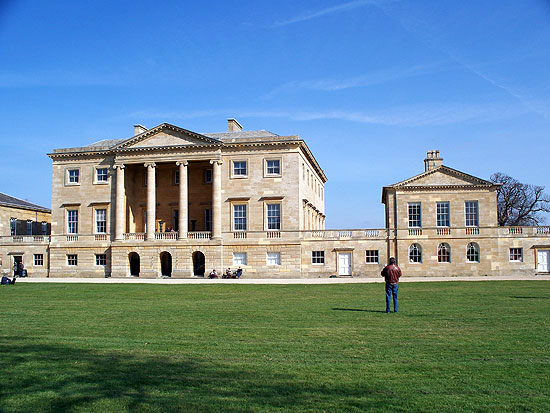
Basildon Park is a Georgian country mansion near Reading. Built for a man who made his fortune in India, it passed through various hands, and when Lord and Lady Iliffe bought it in 1952, it had been unoccupied for forty years except for wartime requisitions, and had escaped demolition but had been stripped of many fittings and decorative features. The Iliffes set about restoring the derelict house to its original grandeur.
Today, a walk from the stable-yard through woodland – part of the park – brings the visitor to the front of the house. The central block is square in plan, with detached service wings tied in by one-storey-high walls which screen service courtyards.
The principal rooms of the main block are on the first floor, with principal bedrooms on the floor above, connected by a grand staircase, a family staircase, and a hidden spiral stair for servants. The ground floor, nowadays occupied by the tea-rooms and function space, was a service area.
The principal rooms on the first floor, the staircase hall, and the principal bedrooms are fully restored and furnished, and well worth seeing. The Old Kitchen in the left wing, though signed, is not open to visitors and seems to be a store or garage. On the other hand, the Iliffe’s 1950’s kitchen in the main house has been restored and opened as an exhibit. Rather more rooms are open to the public than the guidebook (printed 2004) indicates. As well as the 1950’s kitchen these include part of a cloakroom behind the library, and bathrooms and ante-rooms upstairs.
The house is notable for its survival as much as anything. (Visited March 2012)
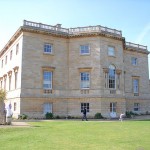
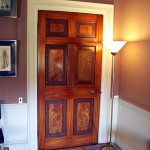
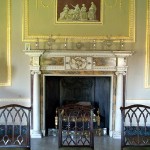
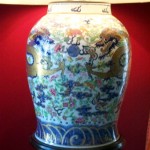
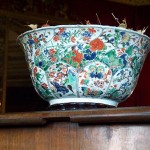
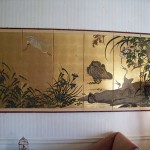
Category: South-east
Location
Red Bull Home Run, Milton Keynes
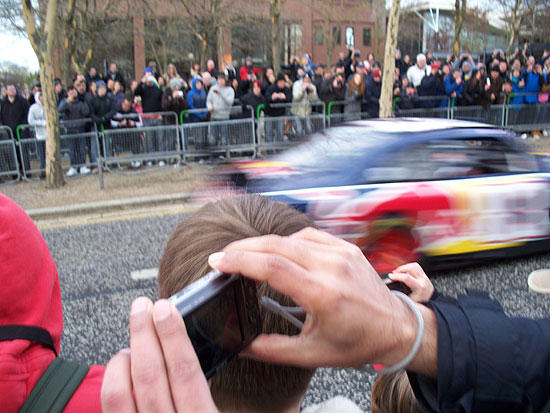
In view of the large predicted turn-out, I decided to travel by train to the conveniently sited CMK railway station. I didn’t arrive too early as the weather was clear but cold and I was hoping a promised parcel might turn up.
I arrived about 15 mins before the show was due to start and found that a very large crowd was already lining the track about 4 deep on both sides. (Some reports put the attendance at 60,000). Accordingly this isn’t so much a report on the Home Run (there are some excellent amateur videos on Youtube) as a report on the difficulty of seeing or photographing anything.
I was hoping to position myself near one of the giant TV screens, but the one nearest the station was throughly obscured by tree branches and the next one was across the road from a long Press stand on the trackside, so that was no use either.
I positioned myself a few hundred yards from the railway station and hoped for the best. In the end, I got to see the Red Bull stunt biker Chris Pfeiffer, the F1 car driven by Mark Webber, the Red Bull NASCAR saloon driven by David Coulthard, the F1 car driven by Sebastian Vettel, and finally both F1 cars and drivers driving side by side. In each case (except the stunt biker) I saw them for about a second as they whizzed past. To get a photo in such a situation it is necessary to start pressing the shutter before the audible but unseen car appears, a near impossible task.
A F1 car is noisy, but less ear-splitting than I expected. The most exciting noise was made by the NASCAR driven by Coulthard.
After that I went home to de-frost, passing up the chance to visit the paddock or see a static F1 car display in the shopping centre. Reportedly, retail takings were up.
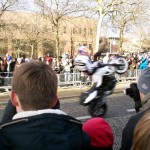
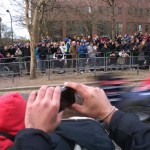
Buckinghamshire County Museum, Aylesbury
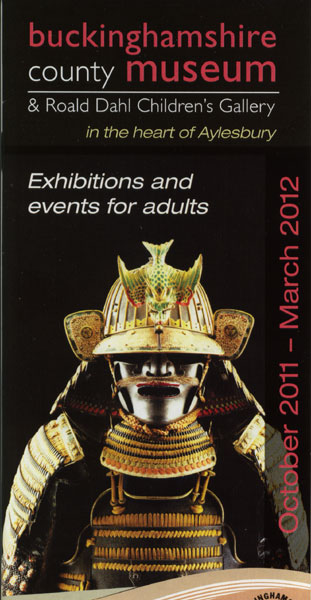 I visited the museum to see the temporary exhibition “Samurai: Warriors of Ancient Japan”. The temporary exhibition had some quality items of historical samurai armour and weapons, from a private collection, together with a few modern blades made using the traditional techniques. Worth a visit.
I visited the museum to see the temporary exhibition “Samurai: Warriors of Ancient Japan”. The temporary exhibition had some quality items of historical samurai armour and weapons, from a private collection, together with a few modern blades made using the traditional techniques. Worth a visit.
Also downstairs was an exhibition of Victoriana, and an area devoted to historic local crafts and industries, and local archaeological finds. There are some things in pull-out drawers.
Upstairs, a prime exhibit is part of the Museum buildings, the “Tudor House” whose structure dates from the Tudor period. Parts of the original wall, roof and floor structures are exposed to view.
The museum is in the old centre of Aylesbury. To visit it by car, first find somewhere you can park for about 2 hours, and then head into the old part of the town centre, looking for signs to the Museum (or the Church, which is nearby). The museum fronts onto Church St, but there is also access from the street behind.
Oxford University Museum of Natural History
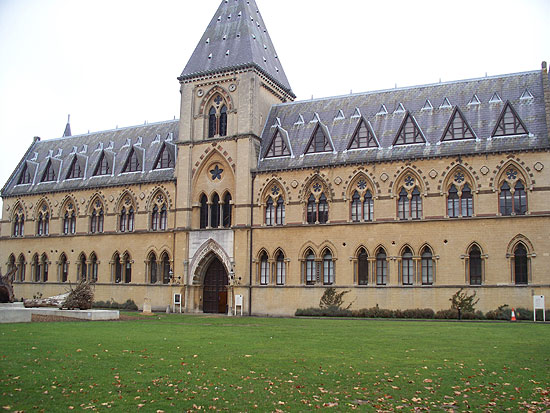
Oxford University Museums
The OUMNH is located in a spectacular Grade I listed neo-Gothic building in Parks Road. Among its most famous features are the Oxfordshire dinosaurs, the dodo, and the swifts in the tower. The Museum’s permanent exhibits are devoted to the history and diversity of life on earth, and to the rocks and minerals from which it is formed. The Museum is an important centre for research and teaching, and is organised into four collections: entomology, geology, mineralogy and petrology, and zoology. It also houses several research libraries, and is home to an environmental archaeology unit.
I spent about an hour in the OUMNH and mainly looked at the dinosaur and mammal skeletons, with a quick look at the insects and other things in the gallery. It’s well worth a visit, and one could spend longer there.
Don’t miss looking at the pillars supporting the upper galleries. Each one is made from a different mineral, identified on the base. Note also the spectacular vaulted metal and glass roof.
I recommend looking at the Museum’s website to help plan your visit.
Practical details: Admission is free. There is no museum café in the Pitt Rivers or the OUMNH, and nothing obvious outside. Travel: Arrival by car is not recommended. The Museum is easily accessible by Park and Ride. The council now charges £1.50 for Park & Ride parking, so have this with you in coin in case you see a bus about to depart! You are not required to display the ticket.
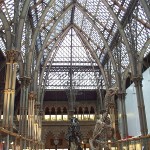
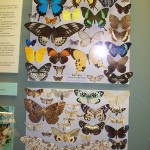
Pitt Rivers Museum, Oxford
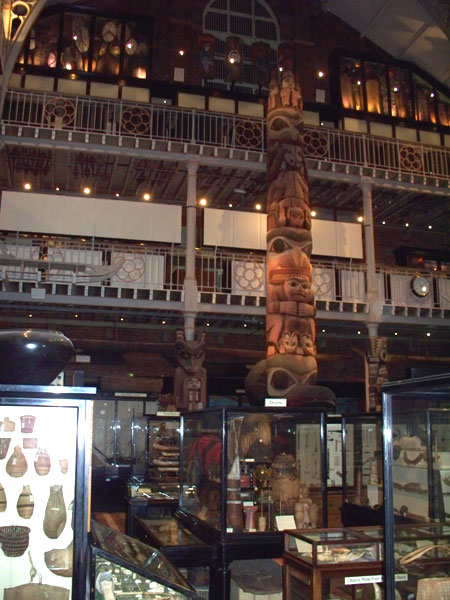 Oxford University Museums
Oxford University Museums
The Pitt Rivers Museum is located behind the OU Museum of Natural History in Parks Road, and is reached by walking through the OUMNH. The Pitt Rivers Museum cares for the University of Oxford’s collection of anthropology and world archaeology.
Permanent displays in the Museum are ethnographic and archaeological and include the following:
Pacific island objects, a collection of ceremonial brasses and ivories from the Kingdom of Benin; a fine group of early masks worn by actors in Japanese Noh dramas; more masks from Africa, Melanesia and North America; sculpture from all over the world in wood, pottery, metal and stone; boats, ranging from full-sized sailing craft to model canoes; baskets in all possible shapes and sizes; pottery from Africa and the Americas, including many pre-Columbian pieces; costumes from North America; magic objects; locks and keys; tools and weapons; musical instruments.
The cases appear to be very crowded, as a very large percentage of the collection is on view. In some instances the ‘displays’ are primarily visible storage, due to the museum being first and foremost a teaching and research institution and the curators are also university lecturers in either cultural anthropology or prehistoric archaeology.
I spent several hours in the Museum. The sheer variety of objects is fascinating, and some are of great interest, while others, like the mummified vulture head, seem a bit mad. Note the fine collection of Japanese Noh masks, the religious objects, or the shrunken heads. The cases are often dimly lit – the Museum apparently can supply torches, or you could bring your own!
I recommend looking at the Museum’s website to help plan your visit.
Practical details: Admission is free. There is no museum café in the Pitt Rivers or the OUMNH, and nothing obvious outside. Travel: Arrival by car is not recommended. The Museum is easily accessible by Park and Ride. The council now charges £1.50 for Park & Ride parking, so have this with you in coin in case you see a bus about to depart! You are not required to display the ticket.
Museum of the History of Science, Oxford
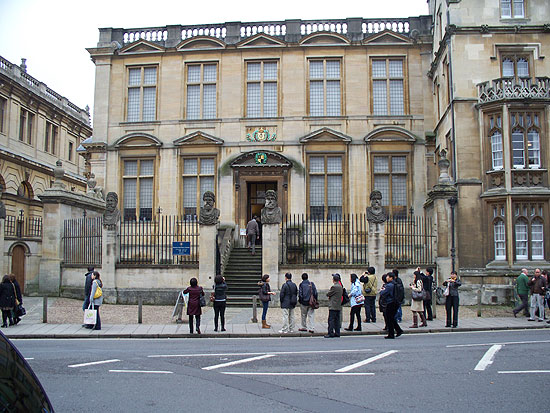
Oxford University Museums
The museum is housed in the world’s oldest surviving purpose-built museum building, in Broad Street. The present collection of the Museum preserves the material relics of past science. Particular strengths include the collections of astrolabes, sundials, quadrants, early mathematical instruments generally (including those used for surveying, drawing, calculating, astronomy and navigation) and optical instruments (including microscopes, telescopes and cameras), together with apparatus associated with chemistry, natural philosophy and medicine.
In case this sounda a bit dry, I should point out that the Museum also has special exhibitions from time to time, and these have included Steampunk Art, and Eccentricity (eccentric objects and behaviour.)
I spent several hours in the museum, and I remember large amounts of polished brass, and a vast collection of astrolabes of all sizes and materials, and different designs, some elaborately engraved.
I recommend looking at the Museum’s website to help plan your visit.
Practical details: Admission is free. The Museum is closed on Mondays. There is no museum café, but you should find refreshments in busy Broad Street. Travel: Arrival by car is not advised. The Museum is easily accessible by Park and Ride. The council now charges £1.50 for Park & Ride parking, so have this with you in coin in case you see a bus about to depart! You are not required to display the ticket.
Ashmolean Museum, Oxford
Oxford University Museums
The Ashmolean, a museum of art and archaeology, is housed in an elegant classically-fronted building in Beaumont Street. Collections include antiquities, Western art, Eastern art, coins, and a cast gallery. Western Art includes some Old Masters. Each of the four main floors has an Orientation Gallery to help you decide what to look at first.
Looking at everything in the Ashmolean would be a major effort, so it would be as well to go armed with some idea of what you want to look at first. If you don’t, there are four Orientation Galleries to help you decide what you are really interested in. I spent several hours in the museum, with a break for lunch, and had a look in most of the galleries, including the coins, and the Japanese galleries (the Japanese collection is in just two rooms). The museum is well worth a visit, and you should fnd something to interest you.
I recommend looking at the Museum’s website to help plan your visit.
Practical details: Admission is free. The Museum is closed on Mondays. There is a museum café in the basement. Travel: easily accessible by Park and Ride. The council now charges £1.50 for Park & Ride parking, so have this with you in coin in case you see a bus about to depart! You are not required to display the ticket.
Rhythm Festival 2011
Rhythm Festival 2011 – Logistics Report.
I bought a day ticket in advance for the Sunday of this 3-day festival. The ticket arrived in good time by post. On arriving at Old Warden on the Sunday morning I found there was no festival traffic, so had to cruise through the village looking for the festival entrance. There wasn’t any trail of temporary signs. There was adequate parking on a field close to the arena entrance.
The festival boasted five stages: the primary outdoor stage, a second outdoor stage, an indoor stage in a marquee, and two more inside buildings. The land in the arena is unusually hilly, which provided complete visual and sound separation between the primary, second and marquee stages. If you want to sit, bring a folding chair. There was a huge beer tent (a handy place to retreat to during a rain shower), and the provision of toilets and catering was also adequate. Interestingly, on the ridge at the back of the primary stage spectator area was a line of tented booths for privileged spectators (corporates or paid extra). In case you needed something else to do there was a cinema marquee and a funfair on site as well.
As for the music, I’m no music reviewer but I enjoyed the music which, headlined by Toots and the Maytals, was clearly aimed at older rock fans. Attendance was of the order of 5000.
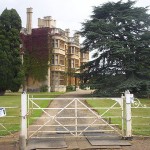
Rhythms of the World Festival 2010, Herts
Rhythms of the World Festival 2010 – Logistics report.
The festival was held at the Priory Park in Hitchin, a green space near the centre of the town. Note that this is a day festival (2 days) and you can buy a ticket for either day, or both. There is no camping.
Parking is an issue here, and the organisers encourage attendees to come by public transport. Hitchin railway station is a mile from the site. There is no on-site parking, and even drop-off outside could be a problem, because of the narrow streets. The official parking was at Butt’s Close, another large green space in the town some 10 mins walk away. For your future reference, the vehicle entrance to Butt’s Close is from Fishponds Road. You will exit on foot from the far end of the parking area. Of course, there are also pay car parks around the town centre.
Before you get in, there is a bag check for excess alcohol, etc.
Once inside, there are at least five stages to choose from. The “World Music” acts all appeared on the main stage, and were generally of a high standard. I saw a Touraeg band from North Africa – wish I could have got a CD of them. Supporting acts on the other stages were a variety of rock, pop, folk, or unclassifiable, and mainly of local, i.e. home counties, origin. Only one of the stages (the church-sponsored one) had seating or cover for spectators.
Considering the quality World Music and the ticket price of under £10 per day, superb value for money. Toilet and catering facilities were adequate.
Cowper and Newton Museum, Bucks
The Museum is situated in a large 17th century house facing the marketplace in Olney. It was the home from 1768-1786 of the poet William Cowper and his companion Mary Unwin. The Rev John Newton, slave trader turned abolitionist and hymn writer, lived nearby at the Vicarage. The building contains two separate houses, known as Gilpin House and Orchard Side, and there are a Georgian walled flower garden and a Victorian kitchen garden at the rear. Today, the building contains museum displays devoted to both men and to local history.
The museum makes an interesting visit,as the displays inform one about both men and about the slave trade, and local history including the local lace-making industry. The 17th century house itself, with its slightly uneven floors and its mezzanine rooms at the back, is an interesting object. The gardens are also worth investigating, and when I visited there was some sort of historical re-enactment going on in the rear one.
Admission charge.
